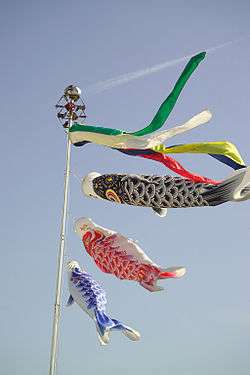Children's Day (Japan)
| Children's Day | |
|---|---|
|
Koinobori: The black carp (Magoi) at the top represents the father, the red carp (Higoi) represents the mother, and the last carp represents the child (traditionally son), with an additional carp added for each subsequent child with color and position denoting their relative age. | |
| Observed by | Japan |
| Type | National |
| Significance | Celebrates children's personalities and their happiness |
| Date | May 5 |
| Related to | Golden Week (Japan), Tango no Sekku, Duanwu Festival, Dano Festival, Tết Đoan Ngọ |
Children's Day (こどもの日 Kodomo no Hi) is a Japanese national holiday which takes place annually on May 5, the fifth day of the fifth month, and is part of Golden Week. It is a day set aside to respect children's personalities and to celebrate their happiness. It was designated a national holiday by the Japanese government in 1948. It has been a day of celebration in Japan since ancient times.
History
The day was originally called Tango no Sekku (端午の節句), and was celebrated on the 5th day of the 5th moon in the lunar calendar or Chinese calendar. After Japan switched to the Gregorian calendar, the date was moved to May 5.[1] It was originally exclusively male celebrating boys and recognizing fathers, but has since been changed to include both boys and girls, as well as recognizing mothers along with fathers.
Until recently, Tango no sekku was known as Boys' Day (also known as Feast of Banners) while Girls' Day (Hinamatsuri) was celebrated on March 3. In 1948, the government decreed this day to be a national holiday to celebrate the happiness of all children and to express gratitude toward mothers. It was renamed Kodomo no Hi.
Celebration
On this day, families raise the carp-shaped koinobori flags (carp because of the Chinese legend that a carp that swims upstream becomes a dragon, and the way the flags blow in the wind looks like they are swimming), with one carp for the father, one for the mother, and one carp for each child (traditionally each son). Families also display a Kintarō doll usually riding on a large carp, and the traditional Japanese military helmet, kabuto, due to their tradition as symbols of strength and vitality.
Kintarō (金太郎) is the childhood name of Sakata no Kintoki who was a hero in the Heian period, a subordinate samurai of Minamoto no Raikou, having been famous for his strength when he was a child. It is said that Kintarō rode a bear, instead of a horse, and played with animals in the mountains when he was a young boy.
Mochi rice cakes wrapped in kashiwa (oak) leaves—kashiwa-mochi (mochi filled with red bean jam) and chimaki (a kind of "sweet rice paste", wrapped in an iris or bamboo leaf)—are traditionally served on this day.
See also
Notes
- ↑ Nussbaum, Louis Frédéric et al (2005). "Tango no Sekku" in Japan Encyclopedia, pp. 948., p. 948, at Google Books
References
- Nussbaum, Louis Frédéric and Käthe Roth. (2005). Japan Encyclopedia. Cambridge: Harvard University Press. ISBN 978-0-674-01753-5; OCLC 48943301
External links
| Wikisource has the text of the 1911 Encyclopædia Britannica article Banners, Feast of. |
| Wikisource has the text of the 1911 Encyclopædia Britannica article Banners, Feast of. |
